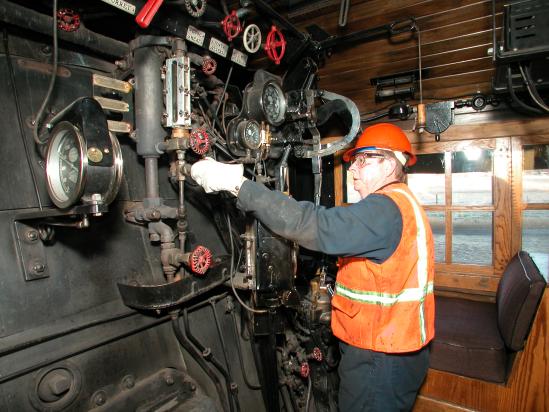Montana By Steam 2002 - Part 11
Oct 21, 2002 Montana By Steam excursion, layover in Sandpoint.
This location on the MRL (Montana Rail Link) is Kootenai at MP 116.9 in the 4th Sub.
Startup procedures
There are two kinds of startup procedures for a steam locomotive: Cold start and hot start. A hot start requires having sufficient residual steam pressure to operate certain key appliances, such as the atomizer, blower, and injector (for an oil-fired steam locomotive like the SP&S 700) and sufficient water level to operate safely. A cold start begins with an external source of steam to bring the boiler to the conditions required by a hot start. After that, they are the same.
You do a cold start in the roundhouse at least one day (usually more) before leaving, then after that, it's hot starts each morning. Each night on the outing, we killed the fire about 10-11pm, after bringing the boiler up to full pressure and water high in the glass, and then lit it again about 4am on running days and 7am on layover days. You want the water high in the glass when you shutdown because as the temperature drops the water will contract and lower the water level, and you will need sufficient water covering the crown sheet when you restart. A hot start and the corresponding shut down have many steps, and only a a few of them are shown here in the photos.

One thing every fireman does at the beginning of his/her shift, whether it's a road fireman, spot fireman, or startup crew, is to blow-down the lines leading to each sight glass (water level glass) and the column to keep those lines free-flowing. As the upper and lower valves are operated, the water level must move with sufficient rapidity to indicate the lines are indeed clear. Photo by Dale Birkholz.

After a sight glass is blown down, the reading is checked against the try cocks (also called gauge cocks) to verify that the sight glass is giving the correct water level. The line of four red handles (just right of center in the photo) control valves that open lines at increasing height on the backhead. Watching and listening as you crack open each valve lets you isolate which two valves the water level is between. Photo by Dale Birkholz.

Opening the tender water valves (or making sure). This one is on the fireman's side supplying the injector. The flexible hose on the left side of the photo carries the water from the tender to the injector housing on the locomotive. The other water line (on the engineer's side) supplies the cold water turbine that pushes the water up to the pilot where the feedwater pump is located. Photo by Dale Birkholz.

Some appliances on a steam locomotive use superheated steam and some use saturated steam and still others use compressed air. Opening the superheat shut-off valve, shown here, allows (some) steam from the superheater manifold to travel back to the manifold on the fireman's control stand, which supplies appliances such as atomizer, tank heat and oil line heat/blowback. While the blower is controlled from the fireman's control stand, a reach rod travels from there under the jacket all the way forward to the blower valve right by the knees of the gentlemen on the right. Photo by Dale Birkholz.

When a steam locomotive has been shut down, steam will condense and collect in lines as water. Parts of the startup procedure involve draining those lines and the photo here shows the blower drain valve being closed after it has cleared. Photo by Dale Birkholz.

Opening the check valves for the lines that bring water from the injector and feed water pump for admission into the boiler. Photo by Dale Birkholz.

Opening the main valve to the turret, which is on top of the locomotive immediately in front of the cab. The turret is a manifold for saturated steam and supplies the appliances that use saturated steam, such as the injector and air pumps. All the valve handles supported by the top plate control admission of saturated steam to an appliance. Notice that one handle is painted gray, while the rest are red. The power reverser is normally operated by compressed air, but can be operated by saturated steam in an emergency when the compressed air system has failed. Photo by Dale Birkholz.

After the steps above (and others NOT SHOWN), we are preparing to light the fire. A lit fusee is placed in the channel iron, which will be advanced into the firebox. Photo by Dale Birkholz.
NOTE: Steam locomotives are NOT all alike. While the fundamental principles are the same, they may vary in details such as placement and control of appliances.